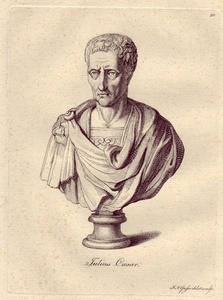| Method | Copper engraving |
| Artist | John Alexander Gresse |
| Published | [Salisbury, 1786] |
| Dimensions | Image 141 x 94 mm, Plate 185 x 133 mm, Sheet 191 x 140 mm |
| Notes |
A portrait bust of Julius Caesar, from James Kennedy's 'A description of the antiquities and curiosities in Wilton-House' (1786). Gaius Julius Caesar (100-44 BC) was born into a prominent but impoverished patrician family, which claimed descent from the goddess Venus, through the hero Aeneas. Well connected politically from an early age through his aunt's marriage to Gaius Marius, the young Caesar established his reputation as an able military strategist, orator, and politician. His skills as a writer of the first rate are evident in his military commentaries. The Gallic Wars, document his command against the Celtic tribes of France, Belgium, and Britain following his consulship in 59 BC. The Civil War outlines his movements following the crossing of the Rubicon in 49 BC, a move which labelled him and his troops as enemies of Rome. Following his success in the Civil Wars, Caesar was declared Dictator, a position he held until his assassination in a Senate meeting at the Theatre of Pompey, on the Ides of March, 44 BC. John Alexander Gresse (1741-1794) was an English draughtsman, painter, and engraver. Born in London, Gresse studied drawing under Gerard Scotin, and and was one of the first students to work in the gallery of casts founded by the Duke of Richmond. In 1777, he was appointed drawing-master to the Royal Princesses. He occasionally practised etching, publishing 'St. Jerome' after Guido, and 'A Satyr Sleeping' after Poussin. Gresse was also a great collector of works of art, and an auction of his collection shortly after his death lasted for six days. |
| Framing | unmounted |
| Price | £25.00 |
| Stock ID | 9250 |

